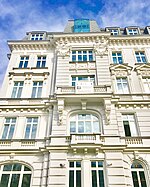Ober Ost
1910s in Belarus1910s in Lithuania1914 establishments in Europe1919 disestablishments in EuropeGerman Empire in World War I ... and 1 more
Poland in World War I

Ober Ost, short for Oberbefehlshaber der gesamten Deutschen Streitkräfte im Osten (lit. "Supreme Commander of All German Forces in the East"), was both a high-ranking position in the armed forces of the German Empire as well as the name given to the occupied territories on the German section of the Eastern Front of World War I, with the exception of Poland. It encompassed the former Russian governorates of Courland, Grodno, Vilna, Kovno and Suwałki. It was governed in succession by Paul von Hindenburg and Prince Leopold of Bavaria, and collapsed during the end of World War I.
Excerpt from the Wikipedia article Ober Ost (License: CC BY-SA 3.0, Authors, Images).Ober Ost
Nowy Świat, Warsaw Śródmieście (Warsaw)
Geographical coordinates (GPS) Address Nearby Places Show on map
Geographical coordinates (GPS)
| Latitude | Longitude |
|---|---|
| N 52.233055555556 ° | E 21.02 ° |
Address
Nowy Świat 26
00-373 Warsaw, Śródmieście (Warsaw)
Masovian Voivodeship, Poland
Open on Google Maps










